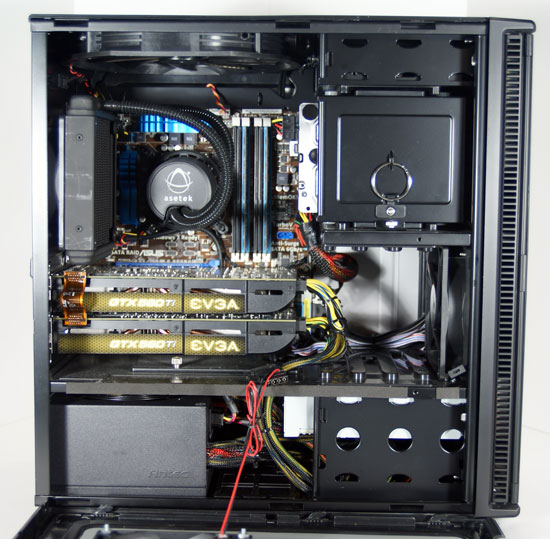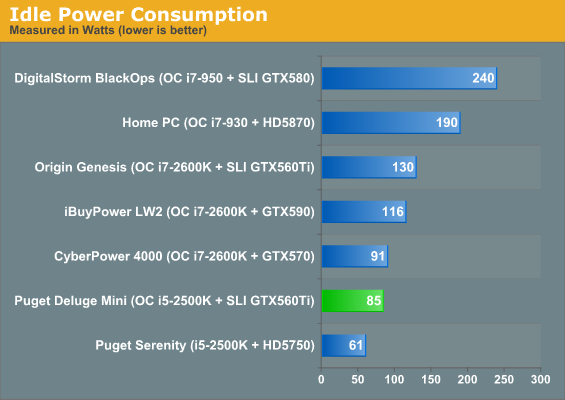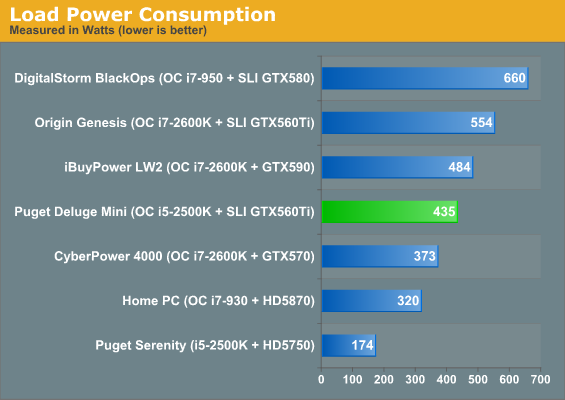Puget Systems Deluge Mini: The Art of Custom
by Dustin Sklavos on April 5, 2011 4:15 PM EST- Posted in
- Systems
- Intel
- Sandy Bridge
- GTX560
- Puget Systems
- NVIDIA
Build, Noise, Heat, and Power Consumption
It's really amazing what a single 120mm fan can do. Build quality is really where the Puget Systems Deluge Mini soars above the competing gaming towers we've tested, just like the Serenity SPCR Edition before it. I've had the opportunity to talk to the CEO of Puget Systems, Jon Bach, about their build process and how they go about designing the machines they sell and this is a good place to get into it.
Before even powerinng on the Deluge Mini there are two things that should immediately come to the astute reader's attention: Puget opts to use the highly-regarded Antec Mini P180 enclosure for this gaming build, and the P180 doesn't typically have a side intake fan. The Mini P180 enjoys all the sound dampening and thermal qualities of its larger siblings in the P180 series, but Puget Systems modifies the case by adding a 120mm intake fan directly above the video cards. The modification is extremely neat and tidy and would go essentially unnoticed to anyone who wasn't already familiar with this chassis. One of Puget's major claims in their build process is the use of thermal imaging to detect hot spots in their builds and weed them out. Adding the intake fan may seem like a "well duh" in retrospect, but it still takes extra time and effort to make the modification and it pays big dividends as you'll see.

Because Puget opts to use the Mini P180 along with a reasonably quiet watercooling solution for the processor, noise is virtually a non-issue with the Deluge Mini. While it's true the video cards do spin up under load testing, this is still overall one of the quietest gaming desktops we've ever tested and it's here that Puget Systems ekes out their major victory in comparison with the Origin Genesis: despite using a smaller chassis with more cramped internals, the Deluge Mini offers comparable gaming performance with both better thermals on the CPU and much better acoustics. That may have something to do with Puget's decision to employ an i5-2500K instead of the i7-2600K, too; on Nehalem-generation processors, losing Hyper-Threading shaves a few degrees off the load temperature of the processor.

The GeForce GTX 560 Ti tandem runs a little toastier in the Deluge Mini, but it's far less audible, and the processor runs substantially cooler despite using comparable voltage to the Origin Genesis and a theoretically less robust cooling system. A visit to UEFI shows what's also the most thoroughly fine-tuned overclocking job we've seen on any boutique system. Offset and turbo voltages have both been carefully adjusted.
This shouldn't completely take away from the Origin Genesis; the i7-2600K in their review unit was fairly power hungry and their engineers did a solid job of tuning the overclock. Puget's build just seems to handle heat better overall.


That fine-tuning really bears itself out in power consumption testing, where idle power is second only to Puget's own Serenity and load power remains very reasonable. Users concerned that the 650-watt Antec TruePower power supply might not be quite enough for this build should be satisfied to see it's got room to spare.
















25 Comments
View All Comments
Velotop - Tuesday, April 5, 2011 - link
I may have to think twice about building my own. Plenty of research time saved with something like this one.michal1980 - Wednesday, April 6, 2011 - link
Why? Just use their 'research' and save a few hunderd bucks. I priced out one of their systems vs newegg, and the difference in price was ~400+ bucks. The only thing missing was their water cooling system. Which is worth what? a 100 bucks max.for 300 bucks, you can get a very decent size ssd a
RaistlinZ - Tuesday, April 5, 2011 - link
For $2,200.00 there's no reason not to have at least small SSD in conjunction with the 1TB WD Caviar Black. I really like the system overall though, and that case is sexy.bplewis24 - Tuesday, April 5, 2011 - link
That was my initial thought as well. I understand there is a premium for them building it, so $100-200 over cost seems reasonable. I'm curious as to how much the liquid cooling adds to the cost. I would likely do away with one of the GPUs and liquid cooling to get it a bit cheaper.scook9 - Tuesday, April 5, 2011 - link
I love this case. For 3 years my desktop was in a Mini P180. It can house 2 full length graphics cards easily with the bottom cage removed and even can fit 3x 1.120mm radiators if you want to watercool (I did it :D)This post has all the pictures of the various incarnations I crammed into that case
http://forum.notebookreview.com/notebook-cosmetic-...
jigglywiggly - Tuesday, April 5, 2011 - link
They just ruined the case by adding that fan on the side, the case is so quiet otherwise... sound dampening materials etc.HangFire - Wednesday, April 6, 2011 - link
Hmm, the review says "one of the quietest gaming desktops we've ever tested", "noise is virtually a non-issue", and "major victory" on "both better thermals on the CPU and much better acoustics".I'm trying to find the "just ruined" in here.
When I build a quiet system I avoid side fans, because it is difficult to keep the side panel from becoming a sounding board and amplifying the noise of the fan mounted on it, and also because the left panel is highly likely to be in line of site of the user's ear.
However just being difficult doesn't mean it can't be done, and it appears Puget Sound has done it, and did it well.
sully213 - Wednesday, April 6, 2011 - link
I have to agree that the side fan is adding "noise", but visual noise, not auditory noise. They can keep the fan itself there, internally mounted, but do away with the ugly fan grill and have a honeycomb or some other pattern of holes for the air to flow through. It provides the same amount of air flow without having a distracting and cheap looking grille mounted to the outside of the otherwise smooth visual line of the case.strikeback03 - Wednesday, April 6, 2011 - link
I agree, if the fan substantially helps temps I'm all for including it, but a black honeycomb/mesh grille mounted from the inside would look a lot less cheesy.Also, isn't this essentially the same watercooling system you complained about in the Origin system? Any idea why it is so much quieter here? And is it only the overclock resulting in the large differences in power consumption?
A5 - Tuesday, April 5, 2011 - link
For the lazy enthusiast, you could just order the base system (with an SSD if you want it - reinstalling Windows after the fact is kind of a pain) and then add in the 2nd card for SLI later, do the OC yourself, and get a big drive for storage on your own to save some coin and avoid the markups. You'd still pay a decent premium, but at least you'd know it worked when it got to your door.